Sep 29, 2009
Mann-made Warming Confirmed
By Chris Horner, Planet Gore
It turns out that trees can scream.
A colleague in the climate-realist blogosphere sends along the following narrative which all Planet Gore readers, even the muttering monitors over at Team Soros, should find very interesting. The inescapable and powerful conclusion is that Mann-made warming is real, while man-made warming remains at best a theory, more likely a hypothesis. Really.
This story deserves to be told.
1: In 1998, a paper is published by Dr. Michael Mann, then at the University of Virginia, now a Penn State climatologist, and co-authors Bradley and Hughes. The paper is named: Northern Hemisphere Temperatures During the Past Millennium: Inferences, Uncertainties, and Limitations. The paper becomes known as MBH98.
The conclusion of tree ring reconstruction of climate for the past 1,000 years is that we are now in the hottest period in modern history, ever.
See the graph here.
Steve McIntyre, a Canadian mathematician in Toronto, suspects tree rings aren’t telling a valid story with that giant uptick at the right side of the graph, implicating the 20th century as the “hottest period in 1000 years,” which alarmists latch onto as proof of AGW. The graph is dubbed the “Hockey Stick” and becomes famous worldwide. Al Gore uses it in his movie An Inconvenient Truth in the famous “elevator scene.”
2: Steve attempts to replicate Michael Mann’s tree ring work in the paper MBH98, but is stymied by lack of data archiving. He sends dozens of letters over the years trying to get access to data but access is denied. McIntyre and Ross McKitrick, of the University of Guelph publish a paper in 2004 criticizing the work. A new website is formed in 2004 called Real Climate, by the people who put together the tree ring data and they denounce the scientific criticism here.
3: Years go by.McIntyre is still stymied trying to get access to the original source data so that he can replicate the Mann 1998 conclusion. In 2008 Mann publishes another paper in bolstering his tree ring claim due to all of the controversy surrounding it. A Mann co-author and source of tree ring data (Professor Keith Briffa of the Hadley UK Climate Research Unit) used one of the tree ring data series (Yamal in Russia) in a paper published in the Philosophical Transactions of the Royal Society in 2008, which has a strict data archiving policy. Thanks to that policy, Steve McIntyre fought and won access to that data just last week.
4: Having the Yamal data in complete form, McIntyre replicates it, and discovers that one of Mann’s co-authors, Briffa, had cherry picked 10 tree data sets out of a much larger set of trees sampled in Yamal.
5: When all of the tree ring data from Yamal is plotted, the famous hockey stick disappears. Not only does it disappear, but goes negative. The conclusion is inescapable. The tree ring data was hand-picked to get the desired result.
These (here and here) are the relevant graphs from McIntyre showing what the newly available data demonstrates.

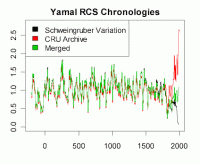
So now the question is, if tree rings scream and their message is one that few want to hear, does their message get heard? See post here.
Sep 29, 2009
Relationship between Solar Cycle Length and Global Temperature Anomalies
Stephen Strum, Frontier Weather, Inc.
The most recent solar cycle, currently estimated to have reached a minimum in December 2008 based on a 12 month centered moving average of monthly sunspot numbers, was the longest solar cycle since 1798-1810, measured trough to trough. The cycle lasted approximately 150 months or 12.5 years, two full years longer than the 20th century average of 10.5 years. The impact of a long solar cycle is two-fold. First of all, there is a definite correlation between the length of one solar cycle and the peak sunspot number during the following cycle as the graph below (enlarged here) shows.
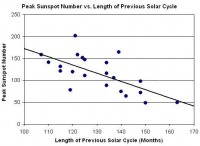
Only two solar cycles since 1750 have lasted as long as or longer than the most recent cycle, and both were followed by the weakest solar maximums of the past 250 years, a period during the early 1800s known as the Dalton Minimum. Given the length of the previous cycle, the upcoming solar cycle could be among the weakest on record since 1750 if the relationship holds. Additionally, of the last five solar cycles that persisted twelve or more months longer than average, four were followed by another cycle lasting longer than average. In every instance, however, the next solar cycle was somewhat shorter in length than the previous cycle.
Since net solar radiation is slightly higher during periods of heightened sunspot activity (and lower during periods of little sunspot activity), the combination of long solar cycles and low sunspot numbers results in cumulatively more months on a decadal time scale with below average net solar radiation. The result is that weak and long solar cycles lead to cooling on a global basis while short and intense solar cycles tend to result in warming on a global basis.
The following plot illustrates the relationship between the length of a given solar cycle and the average temperatures during the following solar cycle. Average global temperatures were calculated for each solar cycle (measured trough to trough) based on the GHCN-ERSST dataset (though the results are similar for the Hadley Center global temperature dataset) and compared to the length of the previous solar cycle. As can be seen, there is a solid relationship between solar cycle length and average global temperatures during the following solar cycle. This in turn leads to the possibility of using the solar cycle length as a means to at least partially predict temperature trends during the upcoming decade (enlarged here).
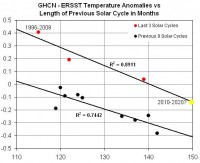
Besides the notable trend of cooler global temperatures following longer solar cycles and warmer global temperatures following shorter solar cycles, the other notable feature of the data is the distinctly higher temperature anomalies observed during the most recent three solar cycles. A trend line fitted through the most recent three solar cycles is nearly parallel to a trend line through the previous nine solar cycles, but is displaced 0.3-0.4įC higher. If the difference was purely the result of CO2 increases, a steadily increasing departure from the previous trend would be expected, and not a distinct jump and then a continuation of the old trend at a warmer temperature level. The timing of the data jump happens to be the mid-to-late 1970s, at a time of a noted global climate shift. The Pacific Decadal Oscillation changed from a negative to a positive phase at that time, and could explain part of the discrepancy. Improved ocean temperature estimates began during that time period as a result of satellite measurements, while at the same time a reduction in the number of land-based observation stations has occurred. Both of those factors, along with issues such as urban heat island growth could also play a role in the observed differences. There is also some chance that the apparent shift is simply an artifact of the limited number of data points. Finally, note that the warm 1996-2008 period followed the shortest solar cycle during the last 150 years. With the most recent solar cycle being the longest cycle of the past 200 or so years, the potential exists for significant global cooling during the upcoming decade. Even if the warmer trends of the past 30 years are utilized, below average global temperatures would still be possible during the next decade if the past trends hold.
While not quite as distinct as on a global scale, temperature trends for North America also have closely followed trends in solar cycle length as the plot below demonstrates. While temperature anomalies will likely not decline as much as might be suggested by the solar cycle length curve, the long solar cycle could at least help to drive North America temperature anomalies back down towards the long-term average (enlarged here).
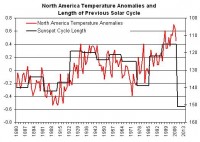
In conclusion, the upcoming decade will provide key data for research into both solar impacts on global climate and human-induced global warming. Since CO2 levels have been rising during a time of increasing solar activity, untangling the impacts of each on the global climate system is difficult. But, with rising CO2 levels and decreasing solar activity during the upcoming decade, the impacts of both should become more evident. See PDF here.
Data Sources:
Global and North America Temperature Anomaly Data.
Monthly Sunspot Number data.
Sep 25, 2009
Chasing a More Accurate Global Century Scale Temperature Trend
By Joseph D’Aleo, CCM, AMS Fellow
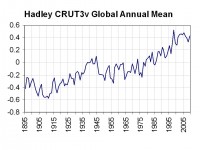
Hadley Centre Annual Mean Temperature since 1895 (enlarged here) shows a warming of about 1C since 1895.
The long term global temperature trends have been shown by numerous peer review papers to be exaggerated by 30%, 50% and in some cases much more by issues such as urbanization, land use changes, bad siting, bad instrumentation, and ocean measurement techniques that changed over time. NOAA made matters worse by removing the satellite ocean temperature measurement which provide more complete coverage and was not subject to the local issues except near the coastlines and islands. The result has been the absurd and bogus claims by NOAA and the alarmists that we are in the warmest decade in 100 or even a 1000 years or more and our oceans are warmest ever. See this earlier story that summarizes the issues.
No one disputes the cyclical warming from 1979 to 1998 that is shown in all the data sets including the satellite, only the cause. These 60-70 year cycles tie in lock step with the ocean temperature cycles and Total Solar Irradiance. The annual mean USHCN temperatures are shown below along with the annual TSI and PDO+AMO. Note the similarities of the current situation with the cooling period of the middle 1900s.
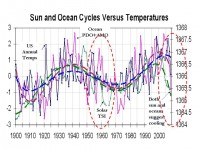
See larger image here.
One needs simply to look at the record highs for the United States and globe to see that the warmest years are not all in the last two decades (although some were to be expected given it is one of two peaks in the cycles). The first image below (enlarged here) shows the decadal state record all-time highs. The 1930s still clearly dominates (24 state all time records) with only one state (South Dakota) in the 2000s tying a 1930s all-time heat record.
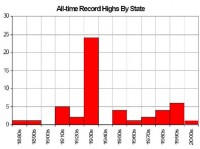
The following image (enlarged here) shows the record monthly highs by individual year. Note the 1930s and 1950s dominate and this decade showing the least record highs than any decade since the 1800s.
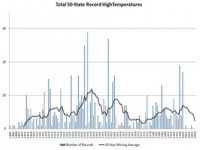
Here is the NCDC compilation of the continental all-time records (enlarged here), note for all the populated continents, the records were in the 1800s and early 1900s.
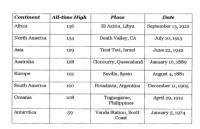
TRYING TO GET AT A BETTER LONG TERM TREND
NCDC removed the UHI effect for the US in 2007 in version 2 of the USHCN. GISS maintains their version of a UHI adjustment of this NCDC USHCN data. By differencing the two, I found the following (enlarged here):
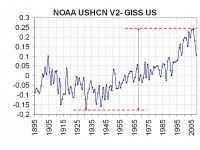
It shows an artifical warming of about 0.45 C or 0.75F for the NOAA data for removal of the urbanization adjustment. Phil Jones of the Hadley Centre, co-authored a paper that showed the UHI contamination of China was 1 degree Celsius (1.8F) for the century, so this contamination appears not to be unreasonable, in fact it may be conservative.
I then took that UHI adjustment for the United States and applied to the global data. The Hadley center data is dominated by land areas with their ocean temperatures mainly coming from ships and in the northern hemisphere. Here’s what Hadley says about marine data “For marine regions sea surface temperature (SST) measurements taken on board merchant and some naval vessels are used. As the majority come from the voluntary observing fleet, coverage is reduced away from the main shipping lanes and is minimal over the Southern Oceans.”
I subtracted the UHI annual contamination from the annual Hadley CRUT3v global temperatures. I got the following (enlarged here):
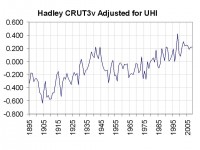
This gives a much more believable view of global temperatures, consistent with the natural forcings and more in line with records shown. The greatest warming was in the early 20th Century. The warming since 1930s and 1940s was negligable (0.2C). It suggests much to do about nothing in DC and Copenhagen. See PDF here.
UPDATE: This post has been changed to include a raw Hadley CRUT3v global plot, a NOAA-GISS difference plot and a corrected adjusted Hadley plot now all in celsius. This is a work in progress and an attempt to see what Hadley plot might look like with an adjustment for UHI that numerous peer review papers suggest is necessary. Your suggestions are welcome (jsdaleo@yahoo.com).
Sep 23, 2009
Sydney dust storm; flight chaos, health worries
By Rohan Sullivan, AP
SYDNEY - Australia’s worst dust storm in 70 years blanketed the heavily populated east coast Wednesday in a cloud of red Outback grit, nearly closed the country’s largest airport and left millions of people coughing and sputtering in the streets.

No one was hurt as a result of the pall that swept in overnight, bringing an eerie orange dawn to Sydney, but ambulance services reported a spike in emergency calls from people with breathing difficulties, and police warned drivers to take it easy on the roads.
Dust clouds blowing east from Australia’s dry interior - parched even further by the worst drought on record - covered dozens of towns and cities in two states as strong winds snatched up tons of topsoil, threw it high into the sky and carried it hundreds of miles (kilometers).
International flights were diverted from Sydney to other cities - three from New Zealand were turned around altogether - and domestic schedules were thrown into chaos as operations at Sydney Airport were curtailed by unsafe visibility levels. Passenger ferries on the city’s famous harbor were also stopped for several hours for safety reasons.
The dust over Sydney had largely cleared by midafternoon, though national carrier Qantas said severe delays would last all day because of diverted and late-running flights.
The dust was still flying further north, however, and the sky over the Queensland state capital of Brisbane was clogged with dust into the early evening.
Such thick dust is rare over Sydney, and came along with other uncommon weather conditions across the country in recent days. Hailstorms have pummeled parts of the country this week, while other parts have been hit with an early spring mini-heatwave, and wildfires.
“It did feel like Armageddon because when I was in the kitchen looking out the skylight, there was this red glow coming through,” Sydney resident Karen told Australian Broadcasting Corp. radio.
The storms - visible as a huge brown smudge in satellite photographs of Australia on Wednesday - are the most severe since the 1940s, experts said. One was recorded traveling from southern Australia all the way to New Zealand some 1,400 miles (2,220 kilometers) away.
Officials said particle pollution in Sydney’s air rose to the worst on record Wednesday, and the New South Wales state ambulance service said it had received more than 250 calls before midday from people suffering breathing problems.
People with asthma or heart or lung diseases were urged not to go outside and to keep their medicine inhalers handy.
“Keeping yourself indoors today is the main thing to do if you have any of those conditions and particularly if you’re a known sensitive sufferer such as children, older adults or pregnant women,” said Wayne Smith, a senior state health official.
Sydney residents coughed and hacked their way through their morning commute, rubbing grit from their eyes. Some wore masks, wrapped their faces in scarves or pressed cloths over their noses and mouths.
“These dust storms are some of the largest in the last 70 years,” said Nigel Tapper, an environmental scientist at Monash University. “Ten very dry years over inland southern Australia and very strong westerlies have conspired to produce these storms.” See story here.
Note the 70 year cycles of solar (Total Solar Irradiance Hoyt/Schatten/Willson) and PDO, AMO (CDC).
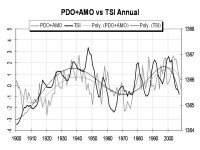
The dryness last year was focused on Victoria in the southeast (recall the fires) while floods opccurred in Queensland in the north. This year it has been wet in the south especially in Victoria while Queensland and northern and central New South Wales have had drought.
Sep 23, 2009
Adapting to climate change through technology
By Paul Driessen
"Since when did you become a global warming alarmist?” I kidded Norman midway into our telephone conversation a few weeks before this amazing scientist and humanitarian died. “What are you talking about?” Dr. Borlaug retorted. “I’ve never believed that nonsense.” I read a couple sentences from his July 29 Wall Street Journal article. “Within the next four decades, the world’s farmers will have to double production on a shrinking land base and in the face of environmental demands caused by climate change. Indeed, [a recent Oxfam study concludes] that the multiple effects of climate change might reverse 50 years of work to end poverty.”
I mentioned that my own discussions of those issues typically emphasize how agricultural biotechnology, modern farming practices and other technological advances will make it easier to adapt to any climate changes, warmer or colder, whether caused by humans or by the same natural forces that brought countless climate shifts throughout Earth’s history.
“You’re right,” he said. “I should have been more careful. Next time, I’ll do that. And I’ll point out that the real disaster won[t be global warming. It’ll be global cooling, which would shorten growing seasons, and make entire regions less suitable for farming.” I was amazed, as I was every time we talked. Here he was, 95 years old, “retired,” still writing articles for the Journal, and planning what he’d say in his next column.
The article we were discussing, “Farmers can feed the world,” noted Norman’s deep satisfaction that G-8 countries have pledged $20 billion to help poor farmers acquire better seeds and fertilizer. “For those of us who have spent our lives working in agriculture,” he said, “focusing on growing food versus giving it away is a giant step forward.”
Our previous conversations confirm that he would likewise have applauded the World Bank’s recent decision to subsidize new coal-fired power plants, to generate jobs and reduce poverty, by helping poor countries bring electricity to 1.5 billion people who still donít have it. For many poor countries, a chief economist for the Bank observed, coal is the only option, and “it would be immoral at this stage to say, ‘We want to have clean hands. Therefore we are not going to touch coal.’” Norman would have agreed.
“Governments,” he argued, “must make their decisions about access to new technologies...on the basis of science, and not to further political agendas.” That’s why he supported DDT to reduce malaria, biotechnology to fight hunger, and plentiful, reliable, affordable electricity to modernize China, India and other developing nations. His humanitarian instincts and commitment to science and poverty eradication also drove his skepticism about catastrophic climate change.
He was well aware that recent temperature data and observations of solar activity and sunspots indicate that the Earth could be entering a period of global cooling. He had a healthy distrust of climate models as a basis for energy and economic policy. And he knew most of Antarctica is gaining ice, and it would be simply impossible for Greenland or the South Pole region to melt under even the more extreme temperature projections from those questionable computer models. He also commented that humans had adapted to climate changes in the past, and would continue to do so. They would also learn from those experiences, developing new technologies and practices that would serve humanity well into the future.
The Ice Ages doubtless encouraged people to unlock the secrets of fire and sew warm clothing. The Little Ice Age spawned changes in societal structure, housing design, heating systems and agriculture. The Dust Bowl gave rise to contour farming, crop rotation, terracing and other improved farming practices. Norman’s dedication to science, keen powers of observation, dogged perseverance, and willingness to live for years with his family in Mexico, India and Pakistan resulted in the first Green Revolution. It vastly improved farming in many nations, saved countless lives, and converted Mexico and India from starving grain importers to self-sufficient exporters.
In his later years, he became a champion of biotechnology, as the foundation of a second Green Revolution, especially for small-holder farmers in remote parts of Africa. Paul Ehrlich and other environmentalists derided his ultimately successful attempt to defuse “The Population Bomb” through his initial agricultural advances, and attacked him for his commitment to biotechnology. His response to the latter assaults was typically blunt. “There are 6.6 billion people on the planet today. With organic farming, we could only feed 4 billion of them. Which 2 billion would volunteer to die?”
The Atlantic Monthly estimated that Norman’s work saved a billion lives. Leon Hesser titled his biography of Borlaug The Man Who Fed the World. Competitive Enterprise Institute senior fellow Greg Conko dubbed him a “modern Prometheus.” Science reporter Greg Easterbrook saluted him as the “forgotten benefactor of mankind.” And the magician-comedy-political team of Penn and Teller said he was “the greatest human being who ever lived.”
He deserved every award and accolade - and merited far more fame in the United States than he received, though he was well known in India, Mexico and Pakistan, where his work had made such a difference.
Norman was also a devoted family man and educator. He served as Distinguished Professor of International Agriculture at Texas A&M University into his nineties. A year and a half ago, he gladly spent 40 minutes on the telephone with my daughter, who interviewed him for a high school freshman English “true hero” paper - and did so just after returning from the hospital and on the one-year anniversary of his beloved wife Margaret’s death.
He told my daughter it was because of Margaret, “and her faith in me and what I was doing, that we were able to live in Mexico, under conditions that weren’t nearly as good as what we could have had in the United States, and I was able to do my work on wheat and other crops.”
I sent him occasional articles, and we talked every few months, about biotech, global warming, malaria eradication, some new scientific report one of us had seen, or some website he thought I should visit. As we wrapped up our early August chat, we promised to talk again soon. Sadly, he entered a hospice and passed away before that could happen.
His mind was “still as clear as ever,” his daughter Jeanie told me, but his body was giving out. To the very end, Norman was concerned about Africa and dedicated to the humanitarian and scientific principles that had guided his life and research, and earned him the 1970 Nobel Peace Prize. Norman left us a remarkable legacy. But as he told my daughter, “There is no final answer. We have to keep doing research, if we are to keep growing more nutritious food for more people.” The world, its climate and insect pathogens will continue to change. It is vital that we sustain the incredible agricultural revolution that Norman Borlaug began.
Paul Driessen is senior policy advisor for the Committee For A Constructive Tomorrow and Congress of Racial Equality, and author of Eco-Imperialism: Green power; Black death.
|
















